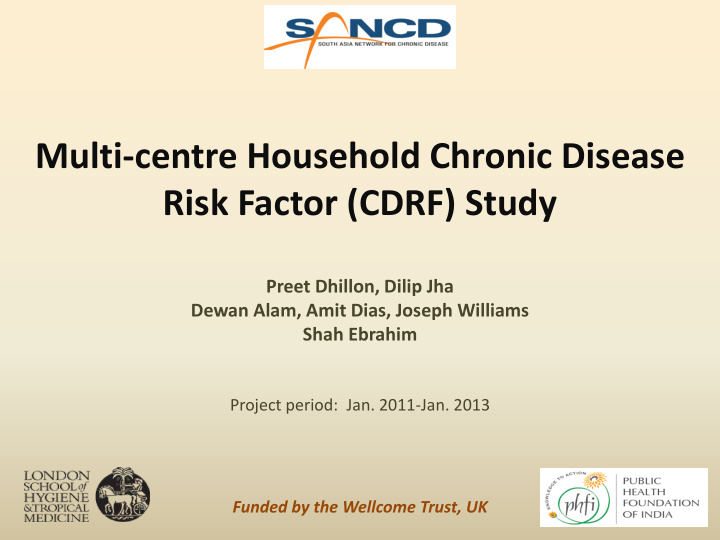



Multi-centre Household Chronic Disease Risk Factor (CDRF) Study Preet Dhillon, Dilip Jha Dewan Alam, Amit Dias, Joseph Williams Shah Ebrahim Project period: Jan. 2011-Jan. 2013 Funded by the Wellcome Trust, UK 1
Objectives Prevalence of household & individual non-communicable disease (NCD) risk factors and outcomes in rural populations Feasibility of community-based interviews, point-of-care diagnostics and electronic data capture Evaluate clustering of NCD’s in households, effects of NCD’s on expenditures, HH members & health care decision-making 2
Methods ◊ Design : Cross-sectional, community-based ◊ Sample size: 250 households x 3 partner sites 3000 total ◊ Study population: Adults Children 2+ years ◊ Locations: Matlab, Bangladesh Carambolim, Goa Sirudhavur, Chennai 3
Data collection ◊ Household-level data - Cooking fuel exposure - Salt, sugar, oil - Household expenditures, insurance ◊ Individual-level data Questionnaires: - Tobacco, alcohol, physical activity, diet, medicine - Disabilities, pain, falls, urinary - Mental health, neighbourhood, networks Physical Measurements: - Anthropometrics, body fat - Lung function, visual acuity, grip strength - Blood pressure, fasting glucose, 24-hr urine
Results Matlab (n=1143) Carambolim (n=1212) Sirudhavur (n=940) Men Women Men Women Men Women 30.5 30.0 29.0 33.6 28.2 30.5 Age, yrs (SD) (22.0) (19.2) (18.4) (19.0) (17.1) (18.1) Education Illiterate 48 47 17 34 20 35 Primary school 23 18 38 35 18 18 Secondary school 30 35 34 28 15 41 Occupation 46.4 96.9 50.4 71.5 41.4 61.0 At home, unemployed, student Unskilled manual, 16.7 1.2 28.2 21 39.3 32.8 farming 16.7 0.3 8.5 1.3 6.3 2.3 Skilled manual 19.6 1.4 12.2 5.6 6.7 2.3 Semi-/Professional Cigarettes/Beedi 46 0 15 6 33 0.3 Tobacco 13 31 14 11 28 28 Alcohol n/a n/a 30 0.2 75 1.4
Results Matlab (n=1143) Carambolim (n=1212) Sirudhavur (n=940) Men Women Men Women Men Women 30.5 30.0 29.0 33.6 28.2 30.5 Age, yrs (SD) (22.0) (19.2) (18.4) (19.0) (17.1) (18.1) Education Illiterate 48 47 17 34 20 35 Primary school 23 18 38 35 18 18 Secondary school 30 35 34 28 15 41 Occupation 46.4 96.9 50.4 71.5 41.4 61.0 At home, unemployed, student Unskilled manual, 16.7 1.2 28.2 21 39.3 32.8 farming 16.7 0.3 8.5 1.3 6.3 2.3 Skilled manual 19.6 1.4 12.2 5.6 6.7 2.3 Semi-/Professional Cigarettes/Beedi 46 0 15 6 33 0.3 Tobacco 13 31 14 11 28 28 Alcohol n/a n/a 30 0.2 75 1.4
Results Matlab (n=1143) Carambolim (n=1212) Sirudhavur (n=940) Men Women Men Women Men Women High fasting glucose (Glucose > 126 mg/dl) - - 10.0 8.0 7.0 4.9 Hypertension (SBP>140 or DBP>90 9.5 10.4 23.6 18.3 15.2 8.8 mmHg or BP meds) Body Mass Index 23+ kg/m2 21 33 27 40 27 32 25+ kg/m2 10 18 15 25 16 21 Depression Any (PHQ>5) 11 20 9 22 37 61 Disability (WHO-DAS II> 5) 9 29 6 19 35 64 Airflow obstruction (Obs. Vs.pred < 0.7) 6.4 2.7 5.1 3.7 10.1 12.3
Exposure to biomass fuel ◊ Household-level questionnaire 2.1 Does the house have electricity? 1=No, 2=Yes 2.2 Primary Fuel Fuel for cooking 1=Kerosene 5=Wood 9=Animal Dung/cake 2=Charcoal 6=Agriculture/crop 10=Shrub/Grass 3=Coal Secondary Fuel 7=Gobar Gas/bio gas 11=Other 4=Gas 12=None 8=Electricity 2.3 Where is the cooking for the household done? 1=Inside the house 2=Inside the house in a separate kitchen 3=Outside the house 4=Both inside and outside 2.4 Does the inside cooking area have the following? Window 1=No 2=Yes, 3=Not Applicable Chimney Exhaust Primary Fuel 2.5 On average, how many months per year do you cook inside? (0-12 months, 99=unknown) Secondary Fuel 2.6 On average, how many months per year do you cook outside? Primary Fuel (0-12 months, 99=unknown) Secondary Fuel
Lung function data ◊ Spirometry – 5 blows (FEV1, FVC, Predicted) ◊ Exclusion criteria: - Surgeries in past 3 months (eg, eye, heart) - Heart attack in past 3 mos, suffers from heart ailment - Pulse > 120 beats/min - Blood pressure greater than 180 (SBP)/ 100 (DBP) - Epilepsy, Pregnant, breast feeding ◊ Re-schedule if: - Respiratory infection, bronchodilators, smoking ◊ Comments – position, unable to complete, unable to understand, refused to cooperate, etc.
Spirometry “A method for assessing lung function by measuring the volume of air a patient can expel from the lungs after a maximal inspiration” It is then compared with predicted normal values based on age, height, ethnicity, gender to gauge airway obstruction ◊ Uses of Spirometry: - Gold standard (other clinical-based measures) - Variations in technical abilities, interpretations - Used to distinguish asthma vs. COPD - Management of respiratory disease - Epilepsy, Pregnant, breast feeding
Airway obstruction ◊ Spirometry data: – FVC : Forced Vital Capacity – total volume of air patient can forcibly exhale in one breath (litres) - FEV1: Forced Expiratory Volume in 1 second- volume of air patient can exhale in the 1 st second of exhalation (litres) - FEV1/FVC: Ratio expressed as a fraction ◊ Interpreting the data: - Normal FEV1/FVC: 0.7-0.8 - Airway obstruction < 0.7 (COPD post-bronchodilator) - Caution with 70+ years (overdx; 0.65 threshold OK) - Flow-volume measurement: traces flow rate against rate of air exhaled to produce a flow-volume curve
Spirometry curve * GOLD : 3 blows that are consistent and within 5% of each other is ideal • Normal: Volume-time curve rises rapidly & smoothly & plateaus within 3-4 seconds
Flow-vol curves
Concluding points ◊ Comparison with national/other data - Similarities: tobacco use, hypertension, depression - Differences: alcohol abuse - First time: physical activity, disability ◊ Gender differences - Health awareness - Tobacco & alcohol use - Depression ◊ Potential – Intra-/inter-household NCD pathways & effects ◊ Challenges – Recruitment to clinics, male migrants, blood donation, spirometry in women
Thank you Wellcome Trust, UK International Centre for Diarrheal Disease Research, Bangladesh (ICDDR,B) Sangath, Goa Voluntary Health Services (VHS), Chennai HealthChakra, HandsRel Ms. Bavani Priya Dr. Rohit Ajgaonkar Ms. Sherin Abraham Dr. Shariful Islam Dedicated field staff Study participants in Matlab, Carambolim & Sirudhavur
Recommend
More recommend